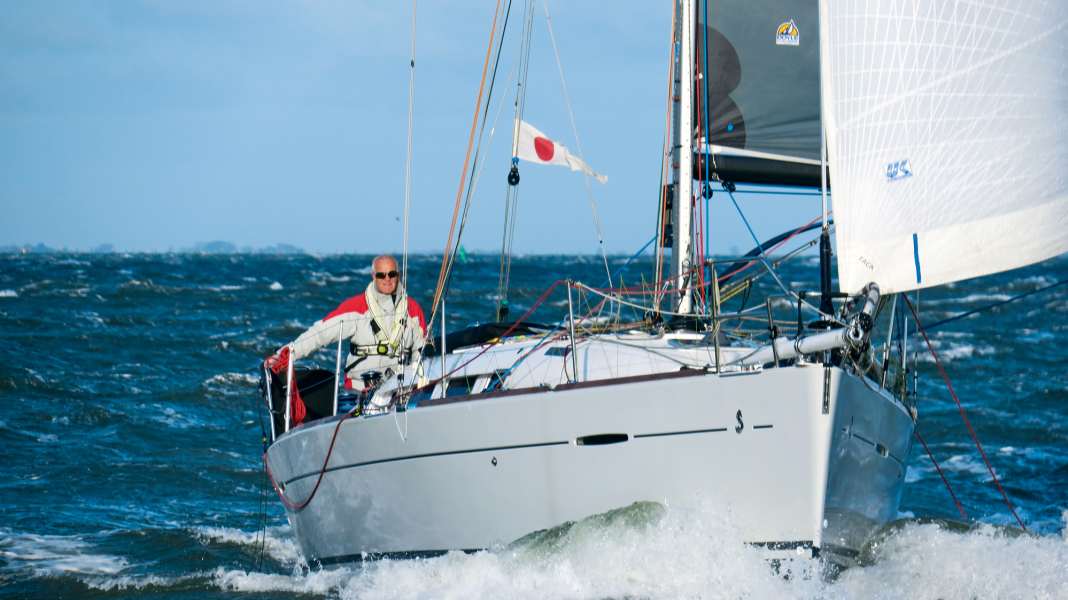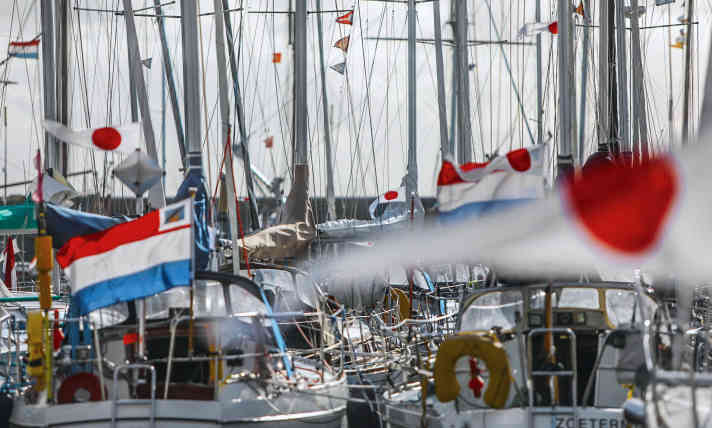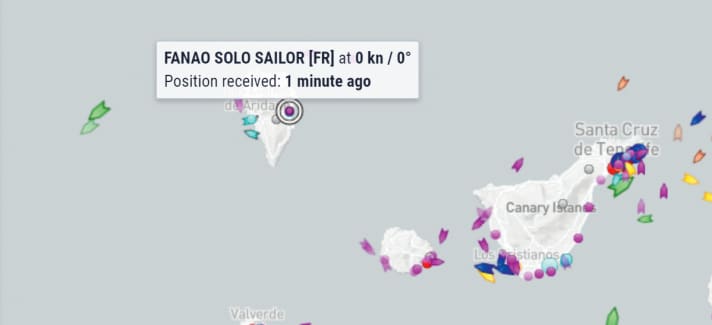Flag management: Number pennant "Unaone" for solo sailors - necessary or unnecessary custom?
Ursula Meer
· 08.03.2023

"When we disembarked in Kornwerdersand, one of the'German' Boat very much that I as'Japanese' I addressed them in flawless German"as one YACHT reader wrote to us after our Article on correct flag management. In fact, the pennant with similarities to the Japanese flag is unknown to most people in this country, even though many are in favour of its use.
In this article:
In the international flag alphabet, the rectangular signals represent letters, while the trapezoidal pennants are reserved for numbers. In first place is "Unaone": a red dot on a white background for the number one. This pennant is seen more frequently at regattas. During the Rolex Fastnet Race, for example, it flutters aft on the yachts in the ORC I class. In other races, the one symbolises the first starting group.
What does the number pennant 1 mean?

Sometimes the "Unaone" also flies on the backstay of a conventional cruising yacht. But then it has a very special meaning. "I fly the single-handed sailing flag on my boat. I'm often asked about it by other sailors. I'm always amazed that the signal is relatively unknown even in sailing circles," writes YACHT reader Hans-Friedel Reicke. As he sails almost exclusively single-handed, the pennant is an advantage for him. Reicke: "I benefit from help when mooring and casting off, for example."
The International Book of Signals assigns a meaning to all the letters and numbers in the flag alphabet. For example, the flag "Victor" with its diagonal red cross on a white background stands for the request for help. For the number pennant "Unaone", however, there is nothing except the number.
The pennant is a good custom here and can be helpful when things get tight on the water".Frank Zaun, organiser of the NRW Cup on the IJsselmeer in the Netherlands
Wikipedia, on the other hand, states in the explanation column next to the corresponding symbol: "Also used by solo sailors." Someone was probably free enough to include this addition, but the pennant is not an official identification mark for solo sailors. Nevertheless, it is sometimes interpreted in this way - and not only in Germany.
Flag flying: "Unaone" not officially recognised
In British sailing forums, members are surprised to discover that although they suspect the origin of the custom lies in the Baltic Sea, they hardly ever see an "Unaone" pennant on holiday there. German sailors also talk about the One. The discussions then often lead to good seamanship: some think it is part of single-handed sailing, others that it should not be used in this sense because it has no official recognition.
It is not known where the pennant was first hoisted by single-handed skippers. However, many traces lead to the Netherlands. The "200 Myls Solo" regatta has been taking place on the IJsselmeer for a quarter of a century. Deliberately "cosy" and with little competitive character, every year on a Wednesday in October up to 140 single-handed skippers with boats of all kinds - fast and slow, sporty and sedate - set off to sail 200 miles at a stretch. They can limit themselves to inland waters or sail around the North Sea. As different as the participants are, they all have one thing in common: their distinguishing mark is the number pennant "one" on the backstay.
The pennant is not mandatory for solo sailors in the Netherlands either
In fact, many sailors whose territory is the Dutch waters report that the pennant is not mandatory there, even beyond the race, but is still quite common. Frank Zaun is the organiser of the annual NRW Cup. This is a three-day regatta event that is also held on the IJsselmeer, which is so close to West German sailors. At the NRW Cup, says Zaun, flying the flag has "pretty much caught on" among single-handed skippers.
Zaun calls this "good custom". It can be quite helpful if it gets crowded on the narrow waterway. But nothing more - please don't derive any rights from it. The pennant can only have a symbolic effect, but it can also be really big: in the harbour of Bruinisse, for example, the local ship chandler offers all flags and pennants in the usual standard formats. The "One", however, is also available in triple size.
"Japanese" can cause curiosities
Frank Winklmeier is another German sailor who has some interesting things to say on the subject. He enjoys taking part in the "200 Myls Solo". Those who sail around it pass the North Sea Canal from Amsterdam to IJmuiden. Flowerbeds and lawns extend to both banks in places. In between, there are dozens of boats that don't have national colours because of the regatta, but all have the red dot on a white background on the backstay. Similar to the letter to the editor mentioned at the beginning, an elderly gentleman once waved excitedly at them from his garden and asked whether they all came from Japan, says Winklmeier. In fact, the "Unaone" is often referred to as a "Japanese" in the Netherlands.

Winklmeier is an avowed fan of the pennant. He has had the best experiences with it and has been trying for a long time to help it become better known in this country too. Incidentally, he happens to be the man who added the explanation "also used by solo sailors" to Wikipedia.
Also in the Netherlands, on the Grevelingenmeer in South Holland, is cruising sailor Oliver Langen and his boat. He also sails the "Unaone" regularly. His voyages have already taken him as far as Portugal and Spain, where he has observed that the One can be seen more frequently. "Perhaps," says Langen, "this is also a selective perception, because single-handed sailors pay more attention to it. After all, apart from other solo skippers, only experts can really do anything with it."
Why is setting "Unaone" still helpful?
Lock keepers and harbour masters, for example, usually know that someone might need help mooring. In England, the harbour master even interrupts his tea break to rush to the jetty. "Others use the radio to direct me to a sheltered place to moor. That's very helpful," says Langen.
The "Silverrudder" around Funen is something like the Danish equivalent of the Dutch "200 Myls Solo". All yachts are sailed single-handed. However, none of the skippers make this clear with the "Unaone". "You know that everyone is travelling alone anyway," explains Wolf André Schmidt. He regularly takes part in the regatta, which is also popular among German sailors - without the pennant. Otherwise, however, Schmidt adds that he uses it occasionally and has had really good experiences with it: "Other single-handed sailors in particular recognise the sign and help in the harbour." He is happy to accept the help, especially when there is a lot of wind or other adverse conditions. But also when the situation is manageable, because the help is often followed by "a little chat, which is really good after a long day alone at sea".
I'm surprised that so few sailors in Germany know Unaone".YACHT reader Hans-Friedel Reicke

The message that someone is alone on board can also be displayed via the on-board technology in addition to the pennant. AIS is a very common method for this. The skippers of the small speedsters on the Mini-Transat add "Solo" or "Solosailor" to their boat names in the AIS, as do those of the Imocas or Class 40, which sail single-handed around the world. If you search for "Solo" on the Marinetraffic website, you will come across a long list of yachts with the suffix in their boat name. Most of them actually fall into the category of racing and regatta yachts. However, there are also some cruising boats among them.
AIS name extension no help for sea rescuers
Depending on the AIS, the extension is not necessarily done in passing; reprogramming the ship's name can take considerably more time than quickly tying a pennant to the backstay. Sailors who spend a lot of time on the open sea are more likely to go to this trouble.
"In an emergency, i.e. in distress at sea, it's good to know that I'm alone on board," is often cited as one of the advantages of the analogue and technical one-hand signal; "then there's no need to search for other people." But this is a misconception: "For the sea rescuers, the one-hand pennant is at best an indication, but never proof that there is really only one person on board," clarifies Antke Reemts from the German Maritime Search and Rescue Association. "It has no significance in the processing of a maritime emergency." The same applies to the addition of the boat's name in the AIS.
Solo glider labelling has no legal relevance
Instead, the sea rescuers recommend that when registering the radio with the Federal Network Agency, a person ashore should be named once who can be contacted within 24 hours. This "crew ashore" should always be informed about the current voyage, the crew and the rescue equipment on board. Alternatively, the "Safe Trx" app from the sea rescuers can be used for this purpose.
From a legal point of view, neither the pennant in its use as a single-handed signal nor the name extension in the AIS has any significance. Conversely, this also means that anyone sailing alone can keep it to themselves with a clear conscience, as there is no obligation to label it. Unless, as a participant in a regatta, you submit to an order from the organiser to this effect.
"Unaone": a custom with advantages and disadvantages
Accordingly, no rights can be derived from the fact that someone identifies themselves as a solo sailor. The German Maritime Traffic Regulations and Collision Prevention Regulations do not recognise "Unaone" or the addition "Solo" in the AIS as a distinguishing feature for single-handed sailors. They remain in force even if the only crew member is working on the main halyard and no one in the cockpit is steering the ship. Or if the skipper is far out at sea and tiredness prevents him from keeping a regular watch.
This leaves the appeal character, the request for consideration and attention: here, a skipper sailing alone wants to let others know that he may not be able to change course quickly or that he may need a helping hand during harbour and lock manoeuvres. Many solo sailors report positive experiences - whether it is that they are generously allowed to sail round or that their lines are accepted.
So both critics and supporters of the pennant have their arguments. Both are right. Because the nice thing about customs is that you don't have to use them - but you can.

